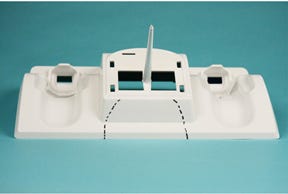Restriction to flow is the problem of the day.
August 25, 2010
Restriction to flow is the problem of the day.
It was good to get back to my office from the oppressive heat of the desert. I love to visit Arizona, but the hot summer there is getting harder and harder for me to handle.
I got up early this morning to hear the sound of the big brown truck arriving at my door, bringing more parts for me to work on. One, with the sprue attached, was molded out of an amorphous material—a PC/ABS alloy, the note said. The problem outlined in the note was that the part had a surface defect just outside the gate area that they had marked so I would not have any trouble finding it.
|
I started my review by checking the part’s wall thickness (around 0.130 inch). The sprue and runner looked suspicious from the start. The sprue O-diameter was 0.150 inch. The diameter of the sprue where it was attached to a half-inch-long cold runner was 0.335 inch, and the sprue was only 3 inches long.
I’m sure you can see where I’m going with this. A typical taper of 1½° will give you 0.0175 inch for each inch of sprue length. So for a sprue length of 3 inches, we should have a taper difference between both ends of the sprue of 0.053 inch instead of a whopping 0.185 inch.
Why is this a problem? It means the nozzle orifice is undersized by some 0.132 inch, and this type of restriction causes pressure losses in the runner and part. The nozzle orifice fitting up against this smaller sprue O-diameter would certainly be some 0.100 inch or more, and this would cause the nozzle heats to rise, preventing the nozzle from freezing off between shots and possibly slowing down the cycle. This problem alone would be cause for a trip to the toolroom for me.
But we had more problems. The short trapezoidal runner was tapered from the bottom of the runner to where it attached to the part, ending up in an edge gate that was 0.100 inch deep. This method of gating always results in a high-shear situation, as well as flow or blush marks just inside the edge gate on the part’s surface. Sprue sizing and runner design are particularly critical since the part is white and PC/ABS is very shear-sensitive.
To correct the sprue taper, I recommended a 0.275-inch sprue O-diameter, keeping the 0.335-inch dimension on the end of the sprue where it attached to the runner. Then, the nozzle needed to be a full-taper rather than general purpose, and the nozzle orifice opened up to 0.250 from 0.080 inch. This type of nozzle change often is enough to make a huge difference in how parts run in any mold.
Finally, the runner would function better as a full-round, and the gate moved to the center of the runner. A depth of 0.100 inch was fine but the land had to change to 0.030 inch.
At this point I felt like I had found all the problems, but I did not want to stop my review until I checked for other issues. And what did I find but a lack of radiusing at all the sharp corners on the back (core) side of the mold. I also noticed some inside corners were radiused and some were not.
|
Surprisingly, some of the corners in the square cored-out areas were radiused on one side, but not the other. I decided just to mention this observation to the molder, since they must not have been seeing any cracking in these sharp corners. Should they find the parts cracking in any sharp corners, all they would need to do is take care of the missing radius.
Testing the Troubleshooter
That was all I needed to review. I called the molder with the good news, ticking off a short list of corrections that needed to be made to fix the silver streaking or flow marks I saw in the marked-out area of his part, and waited for his questions.
He surprised me by not having any, and was going to pass my list of corrections on to his toolroom. No more than three or four days later, I received a box of parts from these guys and found half a dozen parts with sprues attached. I could see they had made all the changes I proposed. The parts looked beautiful in all respects, but a note from the molder asked if a 45-second cycle was about right for these parts.
With a wall thickness of 0.130 inch, a two-plate cold runner mold, and an unfilled amorphous material, I multiplied the 0.130-inch wall thickness by 250 for a rough estimate of 32½ seconds. I guessed that they were probably using a 150-ton machine, so I added 1½ seconds to the rough estimate and came up with a target cycle time of 34 seconds.
I called the molder and told him he should be cycling closer to 34 than the 45 seconds he mentioned. He chuckled and told me he was just testing me to see what I would come with; he was actually running a 36-second cycle. You have to love these guys with their weird plastics sense of humor.
I told him that he should hire me for a couple of days and I would review his shop conditions for things like too many loops in the waterlines and quick disconnects that had 1/8-inch inside diameters that restricted water flow through the mold and slowed down the rate of heat extraction from the mold steel.
We found a mutually acceptable date in both our schedules. It’s nice to be busy at a time when many of our business friends are running kind of slow. I can see things picking up in different parts of the country; it’s just not happening fast enough for me.
The Troubleshooter’s notebook
Part/material: PC/ABS alloy.
Tool: Two-plate cold runner.
Symptoms/problem: Surface defect just outside the gate.
Solution: Decrease sprue taper so nozzle orifice can be enlarged from 0.080 to 0.250 inch to eliminate pressure losses; change nozzle to full-taper design from general purpose; change runner to full round and move it so the gate is in the center of the runner.
About the Author(s)
You May Also Like




